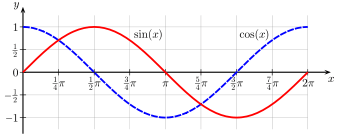Cofunction
This article is about trigonometric functions. For the computer program components, see Coroutine.
In mathematics, a function f is cofunction of a function g if f(A) = g(B) whenever A and B are complementary angles. This definition typically applies to trigonometric functions.[1]
For example, sine and cosine are cofunctions of each other (hence the "co" in "cosine"):
The same is true of secant and cosecant and of tangent and cotangent:
These equations are also known as the cofunction identities.[1]
This also holds true for the coversine (coversed sine, cvs), covercosine (coversed cosine, cvc), hacoversine (half-coversed sine, hcv), hacovercosine (half-coversed cosine, hcc) and excosecant (exterior cosecant, exc):
See also
- Vercosine (versed cosine)
- Havercosine (half-versed cosine)
- Covariance
References
- 1 2 Aufmann, Richard; Nation, Richard (2014), Algebra and Trigonometry (8th ed.), Cengage Learning, p. 528, ISBN 9781285965833.
This article is issued from Wikipedia - version of the 10/21/2016. The text is available under the Creative Commons Attribution/Share Alike but additional terms may apply for the media files.
